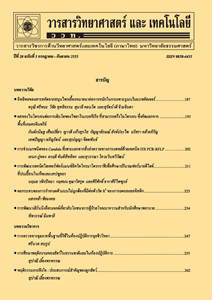ผลของรูปแบบการใช้ที่ดินและสภาพภูมิประเทศต่อความอุดมสมบูรณ์ของดิน บริเวณลุ่มน้ำทุ่งใหญ่ จังหวัดสงขลา
Main Article Content
Abstract
Soil is a limited resource. Using soils must be considered to maintain sustainable. Soil management may affect both soil properties and crop yield. The purpose of the research is to study the effect of land use patterns and topography on soil fertility in Thung Yai watershed, Songkhla province. Land use patterns were as follows, (1) the para rubber plantation area with slope range 0-8 %, (2) the para rubber plantation area with slope range 8-16 %, (3) the para rubber agroforest area with slope range 8-16 %, (4) the para rubber agroforest area with slope range 16-30 %, (5) the orchard plantation area with slope range 16-30 %, and (6) the forest area with slope range more than 30 %. Soil sampling was taken from topsoil 0-15 cm. All the soil samples were analyzed for some important chemical properties in the soil. The obtained soil information was used to evaluate soil fertility status. The result reveals that soil texture of all the topsoils was sandy loam. Soil pH varied from strongly acid to very strongly acid (5.35-5.03, soil : water = 1 : 5), organic matter (OM) as 3.44-21.16 g/kg, available P as 2.20-5.40 mg/kg, exchangeable K as 78.00-152.10 cmol/kg, CEC as 3.16-11.58 cmol/kg, and %BS as 10.41-36.20. The soil fertility status assessment in Thung Yai watershed shows that the para rubber plantation area with slope range 8-16 % has a low level, while other land use patterns have moderate soil fertility status level.
Article Details
References
Land Development Department, 2013, Land Development Department Strategy During the 11th National Economic and Social Development Plan, Available Source: https://www.ldd.go.th/Strategy/2554/strategy_2554.pdf, February 16, 2013. (in Thai)
Neill, C., Piccolo, M.P., Cerri, C.C., Steudler, P.A., Melillo, J.M. and Brito, M., 1997, Net nitrogen mineralization and net nitrification rates in soils following deforestation for pasture across the Southwestern Brazilian Amazon Basin Landscape, Oecologia 110: 243-252.
SEMARNAT, 2002, Evaluación De La Degradación Del Suelo Causado Por El Hombre En La Republica Mexicana (Escala 1 : 250000), Secretaría De Medio Ambientey Recursos Naturales. Memoria Nacional, SEMARNAT-CP/2001-2002, 68 p.
Khanittha, P., 2014, Discharge, Suspended Sediments and Primary Nutrient: A Case Study at Thung Yai Watershed, Hat Yai District, Songkhla Province, Prince of Songkhla University, Songkhla, 75 p.
Land Development Department, 1980, Land Suitability Classification for Economic Plantation, Academic Papers 28th, Land Development, Bangkok, 70 p. (in Thai)
Punsak, T., 2007, Influence of Land Use Changes and Land Use Practices on Soil Quality: A Case Study of Labouya Village, Sanean Subdistrict, Muang District, Nan Province, Maejo University, Chiang Mai, 113 p.
Jumpen, O. and Chakkrit, P., 2018, Soil and Plant Analytic Guideline, Department of Soil Science, Prince of Songkhla University, Hat Yai, Songkhla, 179 p. (in Thai)
Department of Soil Science , 1998, Introduction of Soil Science, Kasetsart University, Bang Khen Center, Bangkok, 547 p. (in Thai)
Department of Mineral Resources, 2014, District Classification for Geological and Mineral Resources Management in Songkhla Province, Department of Mineral Resources, Ministry of Natural Resources and Environment, Bangkok, 144 p. (in Thai)
Wiwutwongwanaa, P., 2003, Soil Chemistry, Facultry of Agriculture, Chiang Mai University, Chiang Mai, 273 p. (in Thai)
Mills, A.J. and Fey, M.V., 2004, Frequent fires intensity soil crusting: Physical chemical feedback in the pedoderm of long-term burn experiments in South Africa, Geoderma J. 121: 45-64.
Rawee, R., 2005, Impacts of Fire on Soil in the Deciduous Forest at Doi Suthep-Pui National Park, Maejo University, Chiang Mai, 167 p.
Watan, P., 2008, Fertility Status of Soil Resources Under Commercial Agriculture Patterns: A Case Study of Huay Sompoi, Chiang Mai Province, Maejo University, Chiang Mai, 144 p.
Supatida, U., 2007, Carbon fractions under agro-ecological land use succession in Khun Samun watershed, Nan province, Northern Thailand, Agric. Res. Extens. J. 24(1): 28-36 (in Thai)
Tossaporn, S., 2010, Soil Fertility Under Intensive Agricultural Land Use in Mae Pae Watershed, Maejo University, Chiang Mai, 160 p.
Pakarat, R., 1992, Forest Soil, Department of Soil Science, Facultry of Agriculture, Khonkaen University, Khon Kaen, 172 p. (in Thai)
Pornchai, P., 2001, Folklore Regarding Agroforestry Ecosystems on The Upper Reaches of The Northern Region, Rubber Authority of Thailand, Department of Agriculture, Bangkok, 127 p. (in Thai)
Tanawat, R., Nattawut, P., Bunjongsak, P. and Prapanuwan, Y., 1996, Integrated Farming System for Soil Conservation on Upland, Chiang Rai Province, Proceeding of The 11th Thailand National Farming Systems Seminar, Department of Agriculture, Bangkok, 420 p. (in Thai)
Chaiyasit, A., 2001, Land Degradation and Strtegies, Academic Conference on The Direction of Natural Resource Management for Soil and Water Conservation in Thailand, Department of Mineral Resources, Bangkok, 31 p. (in Thai)
Pornpan, J. and Wayuree, W., 2001, Soil Erosion in Teak Areas, The Forest Research Office, Royal Forest Department, Bangkok, 16 p. (in Thai)
Ranamukhaarachchi, S.L., Mizanur, R.M. and Shamsun, N.B., 2005, Soil fertility and land productivity under different cropping systems in highlands and medium highlands of Chandina sub-distric, Bangladesh, Asia Pac. J. Rural Develop. 15: 63-76.
Worawit, C., 2004, Soil Nutrient Changes from Various Land Use in Decideous Areas Chiang Dao Wildlife Research Station Chiang Mai Province, Maejo University, Chiang Mai, 125 p.
Praserd, S., Wittaya, S., Somsak, H., Prawpan, K. and Chob, K., 1986, Using Rice Straw Compost that Affects Rice Yield and Soil Properties During 10 years, Department of Agriculture, Bangkok, 357-366 p. (in Thai)


